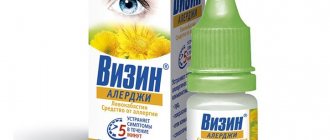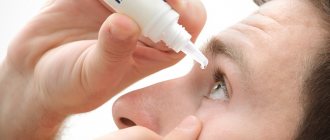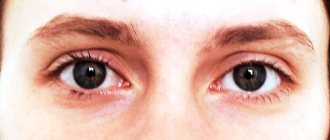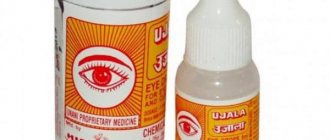Composition and release form
The medicine is available in several forms, the optimal one is selected taking into account the type of disease and test results. You can buy at the pharmacy:
- Pills. They have a biconvex shape with a film shell, the surface is smooth. The color of the core and outer layer is white, the package contains 1 or 2 blisters of 10 pcs. tablets.
- Solution for infusion. Light yellow or colorless transparent liquid. Available with instructions in a cardboard box of 1 bottle of 100 ml.
- Eye drops. Light yellow transparent or colorless liquid. Sold in a plastic dropper bottle of 5 ml.
Different dosage forms are designed to treat specific groups of pathologies. Their main medicinal component is ciprofloxacin, which has an antibacterial effect. The composition of the different forms of the medication is as follows:
| Type of medicine | Main component | Auxiliary components | Shell composition |
| Pills | Ciprofloxacin hydrochloride (291.106/582.211 mg) | Magnesium stearate, talc, corn starch, croscarmellose sodium, microcrystalline cellulose, colloidal silicon dioxide. | polysorbate 80, hypromellose (6 cps), macrogol 6000, titanium dioxide, talc, dimethicone, sorbic acid. |
| Solution for infusion (1 ml) | Ciprofloxacin – 2 mg. | Citric acid monohydrate, sodium hydroxide, lactic acid, hydrochloric acid, sodium chloride disodium edetate, water for injection. | |
| Drops (1 ml) | ciprofloxacin hydrochloride (3.49 mg) | 50% solution of benzalkonium chloride, disodium edetate, sodium chloride, hydrochloric acid, water for injection |
Release form and composition
- film-coated tablets, 250 and 500 mg: flat-cylindrical, biconvex, almost white to white (10 pieces in a PVC/aluminum blister, 1 or 2 blisters in a cardboard package);
- solution for infusion: colorless or light yellow transparent liquid (100 ml in a bottle, 1 bottle in a carton);
- eye drops: colorless or light yellow transparent liquid (5 ml in a dropper bottle, 1 dropper bottle in a cardboard box).
Composition of 1 tablet 250 mg:
- active ingredient: ciprofloxacin – 250 mg;
- auxiliary components: corn starch, microcrystalline cellulose, croscarmellose sodium, colloidal silicon anhydrate, talc, magnesium stearate, hypromellose, sorbic acid, titanium dioxide, macrogol, polysorbate, dimethicone.
Composition of 1 tablet 500 mg:
- active ingredient: ciprofloxacin hydrochloride monohydrate in a dose equivalent to 500 mg of ciprofloxacin;
- auxiliary components: microcrystalline cellulose, croscarmellose sodium, corn starch, magnesium stearate, colloidal silicon dioxide, talc, hypromellose, sorbic acid, titanium dioxide, macrogol, polysorbate, dimethicone.
Composition of 100 ml solution for infusion:
- active ingredient: ciprofloxacin – 200 mg;
- auxiliary components: disodium edetate, sodium chloride, lactic acid, citric acid monohydrate, sodium hydroxide, hydrochloric acid, water for injection.
Composition of 1 ml eye drops:
- active ingredient: ciprofloxacin hydrochloride (equivalent to 3 mg of ciprofloxacin) – 3.49 mg;
- auxiliary components: sodium chloride, 50% benzalkonium chloride solution, disodium edetate, hydrochloric acid, water for injection.
Pharmacodynamics and pharmacokinetics
The instructions for the drug indicate that Tsiprolet is a broad-spectrum antibacterial medication. The active action is aimed at bacterial enzymes that are involved in DNA synthesis, the product completely suppresses them. The use of the drug is aimed at both bacteria at rest and during the reproduction period. The medicine is good and is quickly absorbed after administration. The percentage concentration approaches the maximum value one and a half hours after application and after 2 hours in the interstitial fluid. The medicine easily penetrates organs and tissues.
According to the instructions, Tsiprolet does not affect bacteria that are not sensitive to methicillin antibiotics. There is no medicinal effect on the pathogens of syphilis, ureaplasmosis, or pathogenic fungi. Microorganisms that are inactive to tetracycline drugs do not show resistance. According to the instructions for the drug, the pathogens are counteracted:
- plague;
- dysentery;
- paratyphoid, typhus;
- coli;
- pneumonia;
- acute intestinal infections;
- gonorrhea;
- tuberculosis;
- brucellosis;
- mycoplasmosis;
- chlamydia.
Indications
Mixed bacterial infections caused by sensitive gram-positive and gram-negative microorganisms, in association with anaerobic microorganisms and/or protozoa:
respiratory tract infections (acute and chronic (in the acute stage) bronchitis, pneumonia, bronchiectasis);
infections of the ENT organs (otitis media, sinusitis, frontal sinusitis, sinusitis, mastoiditis, tonsillitis, pharyngitis);
oral infections (acute ulcerative gingivitis, periodontitis, periostitis);
kidney and urinary tract infections (cystitis, pyelonephritis);
infections of the pelvic and genital organs (prostatitis, adnexitis, salpingitis, oophoritis, endometritis, tubular abscess, pelvioperitonitis);
intra-abdominal infections (infections of the gastrointestinal tract, biliary tract, intraperitoneal abscesses);
infections of the skin and soft tissues (infected ulcers, wounds, burns, abscesses, cellulitis, ulcerative skin lesions in diabetic foot syndrome, bedsores);
infections of bones and joints (osteomyelitis, septic arthritis);
postoperative infections.
Indications for use of Tsiprolet
Doctors prescribe an infusion solution or tablets for the treatment of infectious and inflammatory pathologies that are caused by bacteria sensitive to ciprofloxacin. Instructions for use of Tsiprolet provide for the use of the drug for the treatment of the following infections:
- gastrointestinal tract, jaws, mouth and teeth;
- nose, throat, ear;
- biliary tract and gallbladder;
- respiratory tract;
- genital organs (adnexitis, gonorrhea, prostatitis);
- postpartum infections;
- soft tissues, skin, mucous membranes;
- musculoskeletal system;
- urinary tract and kidneys;
- treatment of peritonitis, sepsis.
The solution and tablets, according to the instructions for use, can be part of complex therapy with immunosuppressants for the treatment and prevention of infections in patients with reduced immunity. Eye drops according to the instructions are prescribed for the treatment of infectious and inflammatory diseases of the eyes and appendages due to damage by bacteria that are sensitive to the drug:
- blepharitis, blepharoconjunctivitis;
- acute, subacute conjunctivitis;
- chronic form of dacryocystitis, meibomitis;
- bacterial keratitis, keratoconjunctivitis;
- corneal ulcers of bacterial etiology;
- infectious complications after surgery;
- entry of a foreign body into the eye, infectious complication after injury to the organs of vision;
- drops are used for preoperative prophylaxis in ophthalmic surgery.
Indications for use
Tablets and solution for infusion
Infectious and inflammatory diseases caused by microorganisms sensitive to ciprofloxacin.
Adults:
- lower respiratory tract infections (pneumonia, bronchiectasis, acute bronchitis and exacerbation of chronic bronchitis, infectious complications of cystic fibrosis);
- ENT infections (acute sinusitis);
- kidney and urinary tract infections (cystitis, pyelonephritis);
- genital infections;
- bacterial infections of the abdominal cavity (biliary tract, gastrointestinal tract);
- infections of the skin and soft tissues: infected ulcers, wounds, burns, abscesses, phlegmon;
- infections caused by immunodeficiency while taking immunosuppressants, as well as in patients with neutropenia;
- sepsis;
- peritonitis;
- infections of bones and joints: septic arthritis, osteomyelitis;
- prevention and treatment of pulmonary anthrax.
Children from 5 to 17 years old:
- treatment of complications caused by Pseudomonasaeruginosa in children with cystic fibrosis;
- prevention and treatment of pulmonary anthrax (Bacillus anthracis).
Additionally for solution for infusion: complicated intra-abdominal infections (in combination with metronidazole), including shigellosis, traveler's diarrhea, typhoid fever, peritonitis, campylobacteriosis, prevention of infections during surgical interventions.
Eye drops
Infectious diseases of the eye and its appendages caused by microorganisms sensitive to the drug:
- acute and subacute conjunctivitis;
- blepharoconjunctivitis;
- blepharitis;
- bacterial corneal ulcers;
- bacterial keratitis and keratoconjunctivitis;
- chronic dacryocystitis and meibomitis.
Prevention and treatment of infectious complications after surgery, trauma, and foreign bodies.
Directions for use and dosage
The medicine Tsiprolet is prescribed by the attending physician and writes a prescription for it. The dosage, regimen and duration of treatment depend on the type of infection, severity of the disease, body condition, body weight and age of the patient, and kidney function. There are recommendations for use in the instructions, but these are only general rules. Only a doctor will determine the exact course of treatment based on tests and examination results of the patient.
Tsiprolet tablets
According to the instructions, this form of medication is taken orally before meals on an empty stomach, washed down with plenty of liquid. The doctor prescribes individually the duration of treatment and dose based on clinical indications, taking into account the type of infection, age, weight of the patient and the severity of the condition. There is the following standardized dosage regimen according to the instructions for use:
- for urinary tract and kidney infections: 2 times a day for uncomplicated form, 250 mg, severe form - 500 mg;
- for gonorrhea, take 250 or 500 mg once;
- infections of the lower respiratory tract: 2 times a day, 250 mg for moderate severity and 500 mg for severe;
- complex course of gynecological infections, colitis, enteritis, prostatitis, osteomyelitis: 2 times 500 mg per day;
- for diarrhea, take 250 mg 2 times a day.
On average, the course of treatment lasts 7-10 days until complete recovery, but after the signs of pathology disappear, you need to take the medicine for another 2-3 days. In the presence of severe renal dysfunction, the dosage of the drug is reduced by 2 times. The dose in case of chronic renal failure directly depends on CC (creatinine clearance):
- above 50 ml/min – standard dose;
- 30-50 ml/min – 1 time 250-500 mg at 12 hours;
- 5-20 ml/min – once every 18 hours, 250-500 mg;
- during dialysis, 250-500 mg is prescribed once every 24 hours.
Drops Tsiprolet
This form of medication is used for local treatment by instilling the medication into the conjunctival sac of the infected eye. The recommended dosage according to the instructions is as follows:
- for moderately severe, mild infection: 1-2 potassium every 4 hours;
- severe form of infection: 2 drops every hour, after the condition begins to improve, the frequency of use and dosage should be reduced;
- for a bacterial corneal ulcer, 1 drop is dripped according to the following scheme: 1st day - every 15 minutes for 6 hours, then only during wakefulness every 30 minutes; 2nd day – every hour while awake; Days 3-14 – every 4 hours.
Solution for infusion
The medicine is used intravenously - intravenous drip. According to the instructions, it is possible to mix Tsiprolete solution with 0.9% sodium chloride, 5%-10% dextrose, 10% fructose, Ringer's solution. When prescribing use, one must take into account the type of infection, clinical indications, weight, age, patient conditions, and concomitant diseases. The infusion duration is 30 minutes for 200 mg of the drug. The following dosages are used:
- moderate infections - 200 mg 2 times a day for 7-14 days;
- severe infections - 2 times a day, 400 mg for 7014 days;
- acute gonorrhea – 100 mg once;
- prevention of infections after surgery - 1 hour before surgery, 200-400 mg of Tsiprolet.
Tsiprolet
Suction
Both ciprofloxacin and tinidazole are well absorbed from the gastrointestinal tract after oral administration. Eating slows down absorption, but does not change the maximum concentration or bioavailability.
Distribution
Tinidazole.
Bioavailability - 100%, plasma protein binding - 12%, Tmax after oral administration - 2 hours, Cmax after oral administration of 500 mg - 47.7 mcg/ml.
Ciprofloxacin.
Bioavailability - 50-85%, Vd - 2-3.5 l/kg, plasma protein binding - 20-40%, Tmax after oral administration - 60-90 min, Cmax after oral administration 500 mg - 0.2 mcg/ ml.
Metabolism and excretion
Tinidazole
penetrates into the cerebrospinal fluid in a concentration equal to that in plasma and is reabsorbed in the renal tubules. T1/2 - 12-14 hours. Tinidazole is metabolized in the liver with the participation of the cytochrome P450 (CYP3A4) enzyme system. About 50% is excreted in bile, 25% in the kidneys, and 12% in the form of metabolites. It is reabsorbed in the renal tubules.
Ciprofloxacin
penetrates well into fluids and body tissues (excluding fat-rich tissue, such as nervous tissue). Concentrations in tissues are 2–12 times higher than in plasma. Therapeutic concentrations are achieved in saliva, tonsils, liver, gall bladder, bile, intestines, abdominal and pelvic organs, uterus, seminal fluid, prostate tissue, endometrium, fallopian tubes and ovaries, kidneys and urinary organs, lung tissue, bronchial secretions, bone tissue, muscles, synovial fluid and articular cartilage, peritoneal fluid, skin. It penetrates into the cerebrospinal fluid in a small amount, where its concentration, in the absence of inflammation of the meninges, is 6-10% of the serum, and with inflammation - 14-37%. Ciprofloxacin also penetrates well into the ocular fluid, bronchial secretions, pleura, peritoneum, lymph, and through the placenta. The concentration of ciprofloxacin in blood neutrophils is 2–7 times higher than in blood plasma. Activity decreases slightly at pH values less than 6. Metabolized in the liver (15–30%) with the formation of low-active metabolites (diethylciprofloxacin, sulfociprofloxacin, oxociprofloxacin, formylciprofloxacin). T1/2 - about 4 hours. It is excreted mainly by the kidneys by tubular filtration and tubular secretion in unchanged form (40-50%) and in the form of metabolites (15%), the rest - through the gastrointestinal tract. A small amount is excreted in breast milk. Renal Cl - 3–5 ml/min/kg; total Cl - 8–10 ml/min/kg.
In special cases
The pharmacokinetic parameters of tinidazole in patients with chronic renal failure (creatinine Cl above 22 ml/min) do not differ from those in healthy people.
For ciprofloxacin in chronic renal failure, T1/2 increases to 12 hours. In chronic renal failure (creatinine clearance above 20 ml/min), the percentage of the drug excreted through the kidneys decreases, but accumulation in the body does not occur due to a compensatory increase in the metabolism of the drug and its excretion through the gastrointestinal tract.
special instructions
To avoid the appearance of possible negative reactions from the central nervous system, patients with a history of epilepsy, vascular pathologies, organic brain lesions, according to the instructions, can be prescribed Tsiprolet only for health reasons. If prolonged, severe diarrhea develops during treatment, pseudomembranous colitis should be excluded. If it is confirmed, then the use of the tablets must be immediately discontinued.
There is a risk of inflammation and tendon rupture due to the use of Tsiprolet (solution or tablets). At the first manifestations of pain, tenosynovitis, it is necessary to stop treatment. Parenteral and oral use of the drug must be accompanied by the consumption of a sufficient amount of fluid if normal diuresis is diagnosed. It is recommended to avoid direct sunlight during treatment.
You should not wear contact lenses while treating your eyes with drops. It is forbidden to drip the product subconjunctivally or into the anterior chamber of the eye. If there are other ophthalmic solutions in the treatment regimen, the break between procedures should be at least 5 minutes. During treatment using Tsiprolet, it is not recommended to drive vehicles or machinery.
Side effects of Tsiprolet drops
The medicine is well tolerated by all groups of patients. But sometimes various undesirable reactions from certain organs and systems can be observed.
Itching and burning may occur in the affected organ. Conjunctival hyperemia is noted. Quite rarely, the eyelids swell, tear production increases, and visual acuity decreases. Such symptoms are most often observed with bacterial ulcers and keratitis.
Some allergic reactions may also develop, accompanied by itching and severe redness of the eyes, and the addition of symptoms of intoxication. The development of superinfection and infectious complications of the eyes is possible.
During treatment, you cannot drive a vehicle independently, since visual acuity decreases, which contributes to the inhibition of normal psychomotor reactions necessary in emergency situations.
Drug interactions
The treatment regimen is drawn up by the doctor, taking into account all factors, including compatibility with other medications. It should be taken into account that when taking Tsiprolet simultaneously:
- The concentration of theophylline in the blood plasma may increase, increasing the risk of toxic effects;
- didanosine reduces the absorption of cirpofloxacin;
- drugs containing zinc, aluminum, magnesium, iron and antacids can reduce the absorption of ciprofloxacin; it is necessary to maintain a pause of 4 hours between doses of these drugs;
- NSAIDs (except acetylsalicylic acid) increase the likelihood of seizures;
- cyclosporine increases nephrotoxic effect;
- other antimicrobial medications (metronidazole, clindamycin, beta-lactams, aminoglycosides) provoke synergistic action;
- uricosuric drugs increase plasma concentrations of ciprofloxacin;
- absorption of ciprofloxacin is accelerated by metoclopramide;
- the effect is enhanced and the bleeding time of indirect anticoagulants increases.
To treat individual pathologies, combinations of agents that positively complement each other can be used, for example:
- infections caused by Pseudomonas spp: ceftazidime, azlocillin;
- staphylococcal pathologies: vancomycin, isoxazolylpenicillins;
- streptococcal infections: beta-lactam antibiotics, azlocillin, mezlocillin;
- anaerobic infections: clindamycin, metronidazole
.
Side effects of Tsiprolet
If the rules of use according to the instructions, dosage and drug compatibility are violated, negative reactions may occur from different systems of the body. Solution for infusion, film-coated tablets may cause the following side effects:
- Nervous system: tremor, increased fatigue, dizziness, headache, nightmares, anxiety, insomnia, increased intracranial pressure, sweating, peripheral paralgesia, hallucinations, confusion, depression and other psychotic reactions, cerebral artery thrombosis, migraine, fainting;
- Sense organs: changes in color perception, impaired taste, smell, tinnitus, hearing loss, diplopia;
- Digestive system: flatulence, diarrhea, vomiting, nausea, abdominal pain, hepatitis, anorexia, cholestatic jaundice (if there is a history of liver pathologies), increased activity of alkaline phosphatase, liver enzymes, hepatonecrosis;
- Cardiovascular system: flushes of blood to the skin of the face, tachycardia, heart rhythm disturbances, decreased blood pressure;
- Hematopoietic system: thrombocytosis, hemolytic anemia, leukocytosis, thrombocytopenia, granulocytopenia, leukopenia, anemia;
- Urinary system: interstitial nephritis, polyuria, decreased nitrogen excretory function of the kidneys, urethral bleeding, dysuria, hematuria, albuminuria, glomerulonephritis, crystalluria, urinary retention.
- Musculoskeletal system: tendon rupture, myalgia, tenosynovitis, arthralgia, arthritis.
- Laboratory indicators: hyperglycemia, hypoprothrombinemia, hyperbilirubinemia, hypercreatininemia.
- Allergic reactions: urticaria, shortness of breath, itching, swelling of the larynx and face, eosinophilia, fever, vasculitis, petechiae, increased photosensitivity, Stevens-Johnson syndrome, erythema nodosum, Lyell's syndrome, exudative erythema multiforme, the appearance of blisters with bleeding, the formation of nodules that form scabs .
- Other: general weakness, superinfections (candidiasis, pseudomembranous colitis).
In addition to the above reactions, when using the solution for infusion, a burning sensation, pain at the injection site, and phlebitis may occur. The following side effects are possible when using eye drops:
- Visual organs: itching, conjunctival hyperemia, mild pain, burning. Rarely, lacrimation, photophobia, foreign body sensation in the eyes, swelling of the eyelids, corneal infiltration, decreased visual acuity, keratopathy, and keratitis occur. In patients with corneal ulcers, a white crystalline precipitate may appear.
- Other: allergic reaction, nausea, rarely develops a feeling of unpleasant taste in the mouth, superinfection.
Side effects
Tablets and solution for infusion
- central and peripheral nervous system: increased fatigue, tremor, insomnia, anxiety, dizziness, headache, nightmares, peripheral paralgesia (anomaly in the perception of pain), increased intracranial pressure, including benign intracranial hypertension, confusion, increased sweating, depression and other psychotic reactions that may be accompanied by self-injurious behavior, suicidal thoughts and behavior, up to successful suicide, migraine, agitation, disorientation, hallucinations, fainting, cerebral artery thrombosis, convulsions, vertigo, paresthesia and dysesthesia, hypoesthesia, gait disturbance, coordination of movements, hyperesthesia, peripheral neuropathy and polyneuropathy;
- sense organs: taste disturbances, visual disturbances, tinnitus, hearing loss, impaired sense of smell, impaired color perception;
- cardiovascular system: tachycardia, other heart rhythm disturbances, low blood pressure, prolongation of the QT interval, ventricular arrhythmias, including pirouette type;
- digestive system: abdominal pain, nausea, vomiting, diarrhea, decreased appetite and amount of food consumed, flatulence, cholestatic jaundice (especially in patients with previous liver diseases), pancreatitis, hepatitis, hepatonecrosis;
- hematopoietic system: granulocytopenia, leukopenia, anemia, thrombocytopenia, leukocytosis, thrombocytosis, hemolytic anemia, neutropenia, agranulocytosis, pancytopenia, inhibition of bone marrow hematopoiesis, serum sickness;
- urinary system: hematuria, crystalluria (mainly with alkaline urine and low diuresis), polyuria, dysuria, urinary retention, glomerulonephritis, urethral bleeding, albuminuria, decreased nitrogen excretory function of the kidneys, interstitial nephritis, renal failure;
- respiratory system: breathing problems (including bronchospasm).
The following allergic reactions are possible: the appearance of small nodules that form scabs, the formation of blisters accompanied by bleeding, skin itching, urticaria, drug fever, increased photosensitivity, eosinophilia, petechiae, swelling of the face or larynx, shortness of breath, vasculitis, erythema nodosum, toxic epidermal necrolysis, multiforme exudative erythrema (including Stevens-Johnson syndrome), anaphylactic reactions, anaphylactic shock.
The following laboratory abnormalities are also possible: increased activity of alkaline phosphatase and liver transaminases, changes in prothrombin levels (including hypoprothrombinemia), increased amylase activity, hyperbilirubinemia, hyperglycemia or hypoglycemia, hypercreatininemia.
Other undesirable effects: increased muscle tone, asthenia, myalgia, flushing of the face, muscle weakness, superinfections (candidiasis, pseudomembranous colitis), exacerbation of signs of myasthenia gravis, arthralgia, arthritis, tenosynovitis, tendon ruptures (mainly Achilles), acute generalized pustular exanthema, increase in international normalized ratio (in patients taking vitamin K antagonists).
Additionally for solution for infusion: vasodilation, swelling and pain at the injection site.
Additionally for tablets: eosinophilia, epileptic seizures.
Eye drops
The following undesirable effects are possible: lacrimation, decreased visual acuity, photophobia, mild pain and hyperemia of the conjunctiva, swelling of the eyelids, burning, itching, nausea, sensation of a foreign body in the eyes, the appearance of a white crystalline precipitate in patients with a corneal ulcer, unpleasant taste in the mouth, infiltration corneas, keratopathy, keratitis, development of superinfection.
Overdose
It is important to follow the rules for using the medication prescribed by your doctor or instructions. If adverse reactions develop due to exceeding the dosage, it is recommended to perform the following therapeutic actions:
- ensure monitoring of the patient's condition;
- perform gastric lavage;
- carry out standard emergency measures;
- ensure the supply of the required amount of fluid;
- in the hospital, using peritoneal and hemodialysis, remove the remaining drug.
Tsiprolet - instructions for use
Composition and release form
Ciprolet solution for infusion is a clear, colorless liquid. 100 ml of solution (1 bottle) contains 200 mg of ciprofloxacin;
Ciprolet film-coated tablet 1 tablet contains ciprofloxacin (in the form of hydrochloride monohydrate) 250, 500 mg; 10 tablets per package.
pharmachologic effect
Tsiprolet is an antimicrobial drug from the fluoroquinolone group.
The mechanism of action of ciprofloxacin is associated with the effect on DNA gyrase (topoisomerase) of bacteria, which plays an important role in the reproduction of bacterial DNA. The drug has a rapid bactericidal effect on microorganisms that are both in the stage of rest and reproduction.
The spectrum of action of Tsiprolet includes the following types of gram-negative and gram-positive microorganisms:
E.coli, Shigella, Salmonella, Citrobacter, Klebsiella, Enterobacter, Serratia, Hafnia, Edwardsiella, Proteus (indole-positive and indole-negative), Providencia, Moprganella, Yersinia, Vibrio, Aeromonas, Plesiomonas, Pasteurella, Haemophilus, Campylobacter, Pseudomonas, Legionella, Neisseria , Moraxella, Branhamella, Acinetobacter, Brucella, Staphylococcus, Sreptococcus agalactiae, Listeria, Corynebacterium, Chlamydia.
Ciprofloxacin is effective against bacteria that produce beta-lactamases.
Sensitivity to ciprofloxacin varies among: Gardnerella, Flavobacterium, Alcaligenes, Streptococcus faecalis, Streptococcus pyogenes, Streptococcus pneumonia, Streptococcus viridans, Mycoplasma hominis, Mycobacterium tuberculosis, Mycobacterium fortuitum
Most often resistant: Streptococcus faecium, Ureaplasma urealyticum, Nocardia asteroides.
Anaerobes, with some exceptions, are moderately sensitive (Peptococcus, Peptostreptococcus) or resistant (Bacteroides).
Ciprofloxacin has no effect on Treponema pallidum and fungi.
Resistance to ciprofloxacin develops slowly and gradually; plasmid resistance is absent. Ciprofloxacin is active against pathogens resistant, for example, to betalactam antibiotics, aminoglycosides or tetracyclines.
Indications
Treatment of uncomplicated and complicated infections caused by pathogens sensitive to the drug:
- respiratory tract infections. For outpatient treatment of pneumococcal pneumonia, ciprofloxacin is not a first-line drug, but it is indicated for pneumonia caused, for example, by Klebsiella, Enterobacter, bacteria of the genus Pseudomonas, Haemophilus influenzae, bacteria of the genus Branhamella, Legionella, Staphylococcus;
- infections of the middle ear and paranasal sinuses, especially if they are caused by gram-negative bacteria, including bacteria of the genus Pseudomonas, or staphylococci;
- eye infections;
- kidney and urinary tract infections;
- skin and soft tissue infections;
- bone and joint infections;
- infections of the pelvic organs (including adnexitis and prostatitis);
- gonorrhea;
- gastrointestinal infections;
- infections of the gallbladder and biliary tract;;
- peritonitis;
- sepsis.
- Prevention and treatment of infections in patients with reduced immunity (for example, during treatment with immunosuppressants and neutropenia);
- Selective intestinal decontamination during treatment with immunosuppressants.
Contraindications
Hypersensitivity to ciprofloxacin and other quinolone drugs; pregnancy; lactation; childhood and adolescence.
Use with caution in elderly patients; For patients with epilepsy, a history of seizures, vascular diseases and organic brain damage due to the risk of developing adverse reactions from the central nervous system, ciprofloxacin should be prescribed only for health reasons.
During treatment with ciprofloxacin, adequate hydration is necessary to prevent possible crystalluria.
Directions for use and doses
Tsiprolet tablets should be swallowed without chewing, with liquid. The drug can be taken regardless of meals. Taking on an empty stomach accelerates the absorption of the active substance.
The following indicative doses are recommended:
Uncomplicated lower and upper urinary tract infections - 100 mg 2 times a day.
Complicated urinary tract infections (depending on the severity) - 200 mg 2 times a day.
Respiratory tract infections - 200-400 mg 2 times a day.
Other infections - 200-400 mg 2 times a day.
Acute gonorrhea and acute uncomplicated cystitis in women can be treated with a single dose of 200 mg (intravenously).
For urinary tract infections, including acute uncomplicated gonorrhea, ciprofloxacin can be administered intravenously at a dose of 100 mg 2 times a day. For respiratory tract infections, depending on the severity and pathogen, ciprofloxacin is administered at a dose of 200-400 mg 2 times a day, for other infections - 200-400 mg 2 times a day.
As the patient's condition improves, they switch to taking the drug orally.
It is recommended to continue treatment for at least 3 days after the temperature normalizes or clinical symptoms disappear. The course of treatment is 7-14 days. In patients with reduced immunity, treatment is carried out throughout the entire period of neutropenia.
Side effect
From the cardiovascular system: in very rare cases - tachycardia, hot flashes, migraine, fainting.
From the gastrointestinal tract and liver: nausea, vomiting, diarrhea, digestive disorders, abdominal pain, flatulence, lack of appetite.
From the nervous system and psyche: dizziness, headache, fatigue, insomnia, agitation, tremor; in very rare cases: peripheral sensory disturbances, sweating, unsteady gait, seizures, feelings of fear and confusion, nightmares, depression, hallucinations, disturbances of taste and smell, visual disturbances (diplopia, chromatopsia), tinnitus, temporary hearing loss especially in high sounds. If these reactions occur, you should immediately discontinue the drug and notify your doctor.
From the hematopoietic system: eosinophilia, leukopenia, thrombocytopenia, very rarely - leukocytosis, thrombocytosis, hemolytic anemia.
Allergic and immunopathological reactions: skin rashes, itching, drug fever, as well as photosensitivity; rarely - Quincke's edema, bronchospasm, arthralgia; very rarely - anaphylactic shock, myalgia, Stevens-Johnson syndrome, Lyell's syndrome, interstitial nephritis, hepatitis.
Local reactions: phlebitis
Musculoskeletal system: isolated - ruptures of the tendons of the shoulder, arms and Achilles tendon, requiring surgical intervention. If complaints occur, treatment should be stopped.
Effect on laboratory parameters: especially in patients with impaired liver function, there may be a temporary increase in the level of transaminases and alkaline phosphatase, as well as cholestatic jaundice: a temporary increase in the concentration of urea, creatinine and bilirubin in the blood serum, hyperglycemia.
Contraindications
It is necessary to prescribe Tsiprolet with caution in case of cerebral atherosclerosis, convulsive syndrome, and cerebrovascular accident. Absolute contraindications for any form of medication:
- hypersensitivity to the components of the drug.
- period of pregnancy, breastfeeding;
- individual hypersensitivity to drugs of the fluoroquinolone group.
There are separate contraindications for different dosage forms of the drug. Film-coated tablets and solution for infusion are not prescribed:
- patients under 18 years of age;
- in the presence of pseudomembranous colitis.
The drug should be prescribed with caution to patients with mental pathologies, the elderly, those with severe liver or kidney failure, or epilepsy. Eye drops are contraindicated for:
- viral keratitis;
- under 1 year of age.
Contraindications and side effects
At the end of today’s article, let’s pay attention to the prohibitions regarding therapy with Tsiprolet. The main contraindications to taking this drug are:
Prohibited for nursing mothers
- pregnancy period
- pseudomembranous form of colitis
- lactation
- age up to 18 years
- allergic reaction to Tsiprolet components
It is not prohibited, but it is recommended to take the medication with extreme caution when:
- atherosclerosis of any form
- disorders of blood flow in the vascular structure of the brain
- diseases of a psychosomatic nature
- chronic seizures
- epilepsy attacks
- renal and hepatic pathologies
- old age
Incorrect use of Tsiprolet, expressed in violating the dosage of the drug or ignoring contraindications, provokes the appearance of undesirable reactions. Among the most common side effects are:
- problems with the gastrointestinal tract (bouts of diarrhea, constipation, vomiting, etc.)
- disorders of the central nervous system (migraine, insomnia, tremors, etc.)
- disturbances in the functioning of the senses (problems with taste, smell, vision)
- strengthening of existing pathologies of the heart and blood vessels (jumps in blood pressure, development of tachycardia, etc.)
- malfunction of the hematopoietic system
- exacerbation of urinary system diseases
- allergic reaction in all its manifestations (itching, hyperemia, etc.)
- general malaise
Perhaps this is where the most important provisions regarding the means being considered today have come to an end. As you can see, Tsiprolet is a fairly strong antimicrobial drug in terms of action. We hope that the presented material helped to understand the essence and principles of use of this medication. Good health to you and successful treatment of all pathologies of the body!
Feb 28, 2018
Analogs
If necessary, the doctor can prescribe a structural analogue of Tsiprolet. Popular options include the following medications:
- Ciprofloxacin-AKOS;
- Rocip;
- Tsipromed;
- Quintor;
- Ciprobid;
- Ificipro;
- Ciprobay;
- Cyprinol;
- Tsifran;
- Ciprofloxacin
Tsiprolet price
You can buy the product through an online pharmacy or at a regular dealership. The cost depends on the region of sale and the manufacturer. The approximate price for Tsiprolet in Moscow is as follows:
| Place of sale | Release form | Cost, rubles |
| ZdravZona | Tsiprolet 250 | 46 |
| WER.RU | Tsiprolet 500 | 112 |
| ZdravZona | Tsiprolet A | 177 |
| "Dialogue" | eye drops 5 ml | 45 |
| "Dialogue" | Tsiprolet 500 | 78 |
| "Dialogue" | Tsiprolet A | 158 |
Description and composition of the drug
Tsiprolet is a drug with antibacterial properties. The active component of the drug is ciprofloxacin. This substance belongs to the fluoroquinolone family and helps to actively suppress the activity of pathogens such as Klebsiella, staphylococcus, streptococcus, enterobacteria, chlamydia, E. coli, citrobacter, diphtheria corynebacterium, etc.
The auxiliary components of the medicine include:
- Mannitol.
- Acetic acid.
- Sodium acetate.
- Water.
- Benzalkonium chloride.
The medication is available in the form of tablets, injection solution or eye drops.
On the shelves of pharmacies you can also find another form of the drug in question - Tsiprolet A. This drug is available in tablet form. Its difference from the usual Ciprolet lies in the presence of two active components in the tablets: ciprofloxacin and tinidazole.










